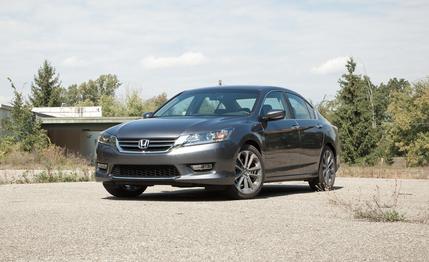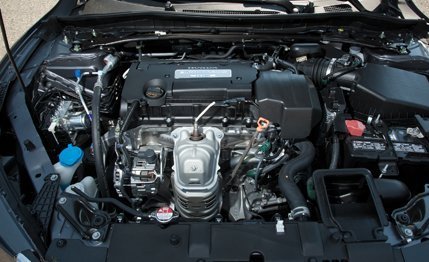 Instrumented Test
Instrumented Test

For decades, the Honda Accord seemed to be the automotive embodiment of Nietzsche’s concept of eternal recurrence. Every few years a new version would appear, win awards (including multiple appearances on our own 10Best Cars list), rank near or at the top of the sales charts, and take its familiar place in the fabric of American society. In this way, the Accord generally fulfilled the theory that the universe and its events have already occurred and will recur ad infinitum.
But around the time the eighth-generation model arrived for 2008, the cosmos apparently skipped a beat, and the Honda began to buckle slightly under the burden of success. Although the Civic took the lion’s share of the criticism, we noted a few small cracks in Honda’s mid-sizer in a family-sedan comparison test from earlier this year. The four-cylinder engine and the five-speed automatic transmission still operated with Honda’s trademark smoothness, but the former sounded coarse under full boot, and the latter was one cog short of the segment-standard six-pack. At various times we have also noted the outgoing Accord’s undignified exterior styling and overly busy cockpit erratically littered with buttons. That’s not to say the car wasn’t great—the previous model was a perennial 10Best winner, after all—only that it was being reeled in by the competition, notably, the winner of that comparo, the Volkswagen Passat.
Restoring the Natural Order of the Automotive Universe

We’re happy to say that the 2013 Accord tested here—a manual-transmission, four-cylinder Sport model, which differs from other trims mostly through aesthetics—benefits from a lightened load not only metaphorically but also physically. The car’s steering, braking, and shifting are all light to the touch yet operate with surgical precision. Even the slightest driver inputs produce tangible results. The electrically assisted rack-and-pinion steering is slack-free throughout its full 2.5-turn lock-to-lock travel yet is never twitchy or overly eager. The clutch is equally light, pedal pressure remaining consistent throughout its travel—its operation is intuitive from the first press. And shifting the new six-speed manual (a CVT is optional) recalls the familiar Honda manual-transmission exactitude that awed so many drivers way back when the brand was still making its bones in this country. Braking is a paragon of temperate behavior. How deep you go into the pedal is directly correlated to clamping power, and it hides no secrets along its relatively short length of travel.

And as well as the components perform independently, they work even better in unison. Wearing 18-inch wheels shod with 235/45-18 rubber, this Accord managed a respectable 0.87 g on a 300-foot skidpad, but it was while cutting delicate arcs through the wooded environs of our 10Best test loop that the chassis and the powertrain really began to communicate with us on a first-name basis. As we’ve previously noted, the Accord has swapped its front control arms for struts (Honda says they are lighter and deliver lower levels of NVH); the Accord Sport and all higher trims receive a front strut-tower brace. Our scales pegged the Accord’s weight at 3272 pounds with a front-heavy 59.6/40.4-percent weight distribution. Despite this, turn-in is crisp and neutral, the chassis eagerly following the directions given by the front wheels. Only under hard acceleration over broken pavement did we experience any directional drama, most of it in the form of front wheelspin and hop; the rear end stayed firmly planted on all but loose gravel.
Power in the Accord Sport comes from a 189-hp version of Honda’s new, direct-injected 2.4-liter four-cylinder. (The LX, the EX, and the EX-L have 185 horses; to get six cylinders, step up to the EX-L V-6 or Touring, please.) All 181 lb-ft of torque—20 more than in the previous-gen EX’s four-cylinder engine—appear by 3900 rpm, which makes it possible to inject some thrills into the daily commute without winding each gear to the 6800-rpm redline. Of course, if you wish to play, the powertrain is ready and willing, as evidenced by our notes from the test track: “Plenty of low-end torque, so you’ll want to launch around 2500 rpm and spin the tires to redline. Very easy to approach the rev limiter and then shift at just the right time.” The 6.6-second scoot to 60 is mighty impressive—it’s 1.3 seconds quicker than that of a last-gen four-cylinder with a manual—and the car covered the quarter in 15.3. Those in the mood to save fuel rather than time can select the Eco Assist mode via an econ button to the left of the steering wheel; it alters the operating characteristics of the climate control and remaps throttle response in the name of efficiency.